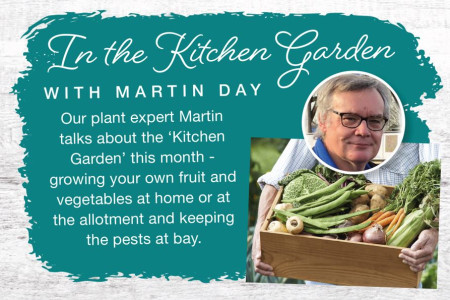MARCH: In the Kitchen Garden with Martin Day
It’s been an interesting time in the kitchen garden where the sudden very cold spells have caused a lot of damage to vegetables which normally happily overwinter: Swiss chard and beetroot have turned to mush as have some of the brassicas which are usually fine in this area e.g., cauliflowers. The fruit seems to have overwintered more successfully and any plants in the ground seem fine: fruit grown in pots may need checking as if the compost is frozen for too long or too often it can damage the roots (even during the -10C weather we had only the top couple of centimetres of soil frozen so less damage occurred in this case).
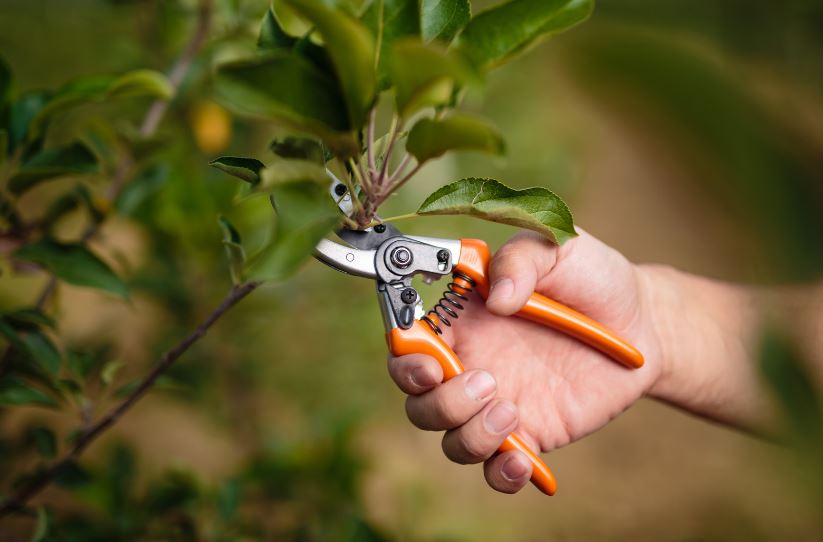 Fruit
Fruit
It’s pruning time for apples, pears and quinces (and medlars if you are lucky enough to have one) if you haven’t already pruned them. Winter season pruning needs to be done before mid-March when the buds will break.
This applies to bush forms: trained forms such as cordons and espaliers are best pruned in late summer. Start by considering the “three Ds” of Dead, Diseased and Damaged and remove those branches first, and sort out any branches that cross (if they rub they will potentially allow disease to enter through the wound). Recently planted trees will need formative pruning to help them form the shape you want – usually an open goblet shape. If left unpruned new trees will produce a lot of vertical growth which will be harder to manage in later years, and older trees get congested with too many branches and will suffer from pests, diseases, and poor fruit quality if the air flow around them is poor. The RHS website is useful for more information. Remember to dispose of any mummified fruit still in the tree as this will encourage disease to spread into the branches behind the fruit.
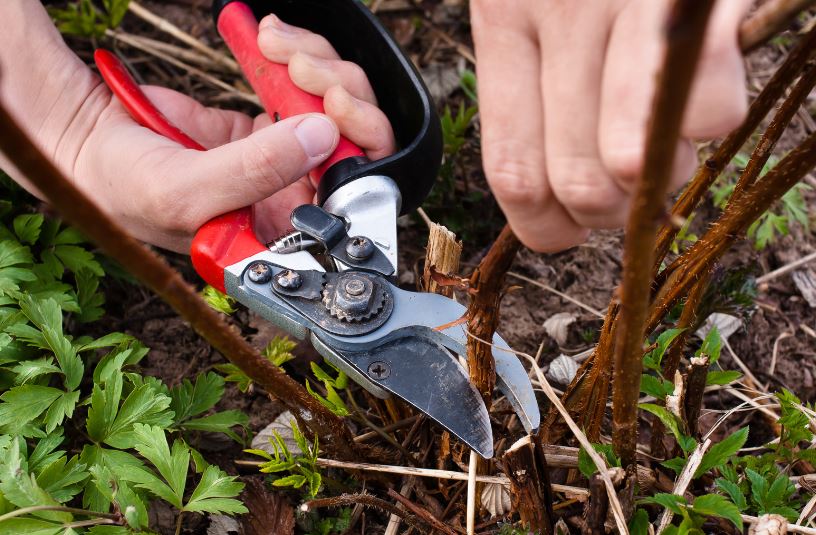
Stone fruit (Cherries, Plums, Apricots, Peaches etc) pruning should only be done between July and September to avoid disease getting into the trees and preferably on a hot, sunny day.
Bush fruit can be pruned now: remember that blackcurrants crop best on one year old wood whilst other currants crop on two or three year old stems. Autumn fruiting raspberries can have last year’s canes cut down to the ground to make way for this year’s canes and crop.
All fruit will benefit from a spring feed using Vitax Q4 or another balanced feed. We have good stocks of top fruit and soft fruit which can be planted now to get them established for the coming year.
To control Codling moth in apples and Plum moth in plums think about using pheromone traps which will remove most of the male moths near your trees. A high number of moths in the sticky trap indicate that an insecticide spray may be needed if you are comfortable using one.
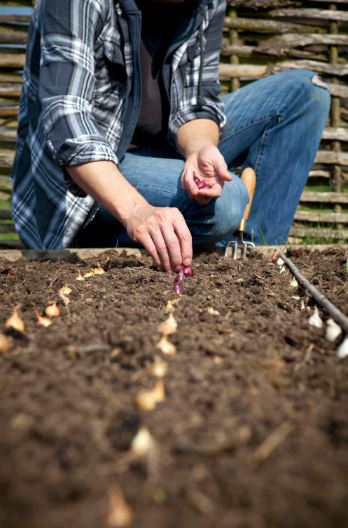 Vegetables
Vegetables
In the vegetable garden it’s time to plan ahead for this year’s crops: after a cold winter it would be useful to get the soil warmer before planting or seed sowing as well as removing the weeds before they grow too much. Covering the soil in the vegetable beds with black plastic or weed control fabric will both warm the soil and kill the weeds off by excluding the light from them.
Hardier vegetables can be sown direct from March onwards eg carrots, parsnips, Swiss chard, radishes and broad beans amongst others. The cold weather killed off my over-wintering broad beans so I will be re-sowing them shortly. Cloches or a layer of horticultural fleece over the sown seeds will raise the soil temperature and help protect the seedlings from frost.
Vegetables to plant out now include onion sets, shallots and garlic. There’s still time to buy seed potatoes ready for planting from mid-March onwards: it’s best to keep the tubers in a light, frost-free cool place until you are ready to plant them, to avoid them forming lots of spindly shoots which will get damaged and reduce their vigour. Asparagus crowns can be planted for a long-term crop of fresh spears if you have the space and are a rewarding crop.
If you have somewhere warm and sheltered, you can start by sowing more tender vegetables off inside such as peppers and tomatoes. Squashes and sweetcorn can wait until April.
Our range of vegetable seedlings and plants will be available from the middle of March onwards and is a great way of getting a quick crop if you haven’t got the time or space to start plants off indoors.
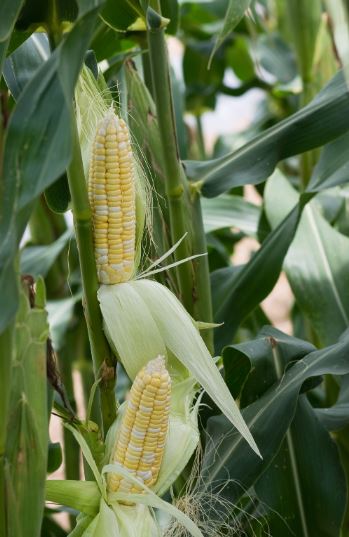 It will be interesting to see what the weather does this year: most crops coped well-enough with the hot dry weather if watered well-enough, and spot-watering the plants kept the weeds from growing in the dry spell. Sweetcorn did really well so long as it was protected properly from pests such as birds and mice: the easiest method is to tie a sock over the developing cob which worked well for lots of people last year. Personally, the main disappointment was my runner beans: not getting enough water to them during the hot weather (despite frequent watering and using a mulch) meant that even small beans were stringy. I’ll be digging a larger trench this year and including more moisture-retaining material. Traditional methods include lining the bean trench with newspaper, and/or digging in lots of compost. Using old compost bags to line the sides of the trench would help a lot too. French climbing beans seem less affected by dry weather, so I’ll be trying half and half this year.
It will be interesting to see what the weather does this year: most crops coped well-enough with the hot dry weather if watered well-enough, and spot-watering the plants kept the weeds from growing in the dry spell. Sweetcorn did really well so long as it was protected properly from pests such as birds and mice: the easiest method is to tie a sock over the developing cob which worked well for lots of people last year. Personally, the main disappointment was my runner beans: not getting enough water to them during the hot weather (despite frequent watering and using a mulch) meant that even small beans were stringy. I’ll be digging a larger trench this year and including more moisture-retaining material. Traditional methods include lining the bean trench with newspaper, and/or digging in lots of compost. Using old compost bags to line the sides of the trench would help a lot too. French climbing beans seem less affected by dry weather, so I’ll be trying half and half this year.
If you grow fruit, you probably had a bumper year last year: apples and pears didn’t produce much in 2021 due to bad weather at blossom time resulting in poor pollination and fruit set. They made up for it in 2022 by producing massive crops so may well be having a rest this year with smaller crops unless you thinned the crop heavily (I was too busy watering to manage this very thoroughly!). This year could thus be the one to get your fruit back into shape if it has slipped in recent years!
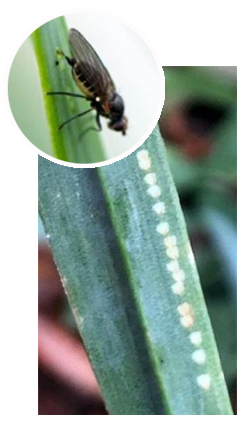 Do keep an eye out for pests and diseases: Allium leaf miner is proving to be a nuisance in the local area and has caused leek crops to go from healthy to collapsed and barely edible within a very short space of time. Use Enviromesh to keep the fly off the alliums (it can also affect garlic, onions, and shallots to a lesser extent) and if you are comfortable with using pesticides spray regularly with an insecticide such as Bug Clear Ultra or Provanto Ultimate Bug Killer. These are both systemic so will get into the plant tissues and kill the eggs and larvae of pests. Check the harvest intervals and number of treatments allowed which is shown on the back of the packet. Organic contact only alternatives are available and will help to a more limited extent.
Do keep an eye out for pests and diseases: Allium leaf miner is proving to be a nuisance in the local area and has caused leek crops to go from healthy to collapsed and barely edible within a very short space of time. Use Enviromesh to keep the fly off the alliums (it can also affect garlic, onions, and shallots to a lesser extent) and if you are comfortable with using pesticides spray regularly with an insecticide such as Bug Clear Ultra or Provanto Ultimate Bug Killer. These are both systemic so will get into the plant tissues and kill the eggs and larvae of pests. Check the harvest intervals and number of treatments allowed which is shown on the back of the packet. Organic contact only alternatives are available and will help to a more limited extent.
Whatever the weather – we wish you a successful year of GYO, and don’t forget, we are always available for up to the minute advice.


